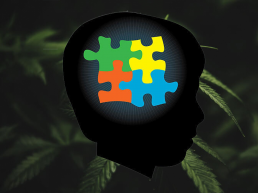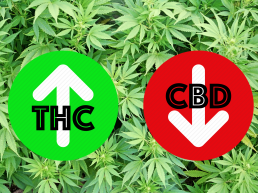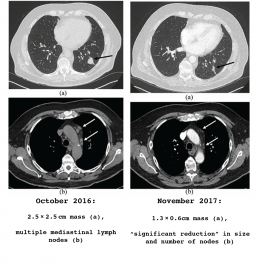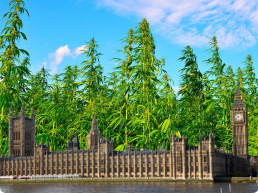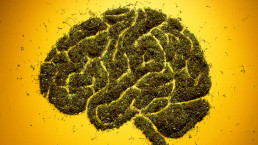Study finds legalising medicinal cannabis reduces traffic fatalities by “nearly 9 percent”
Study finds legalising medicinal cannabis reduces traffic fatalities by “nearly 9 percent”
- States which legalised medical cannabis saw “traffic fatalities by 9%”
- Legalising medical cannabis is also associated with “decreased beer sales”
- One study even found that “low concentrations of THC do not increase the rate of accidents, and may even decrease them”
One of the leading arguments against legalising cannabis, even for medicinal use, is that it will lead to an increase in traffic accidents due to an increase in stoned drivers.
While there is evidence that driving under the influence of THC impairs certain driving functions, several studies are now questioning whether legalising cannabis has any valid links to an increase in fatal road traffic accidents.
Researchers at the University of Colorado-Denver looked into traffic accident fatalities in 16 states which had legalised access to medical cannabis, surprisingly finding that these states actually saw a decrease in traffic deaths.
Using data from the National Survey on Drug Use and Health (NSDUH) from 1990-2009, researchers found that states which legalise medical cannabis see “traffic fatalities fall by nearly 9%.”
“We went into our research expecting the opposite effect,” explained Daniel Rees, study co-author.
This is not to suggest that cannabis makes you a better driver.
Researchers believe that the main reason MMJ (medical marijuana) states see a reduction in fatal traffic accidents is because cannabis can act as an effective substitute for alcohol.
According to the study, legalising medical cannabis “leads to a decrease in alcohol consumption,” especially among those aged 20-29, and there is also an “associated with decreased beer sales, the most popular alcoholic beverage among young adults.”
The study also found that while legalisation does lead to an increase of consumption among adults, there was “no evidence that the use of marijuana by minors increased,” challenging another common argument used against legalising cannabis.
Due to this substitution of alcohol for cannabis, in states which legalised medical cannabis, researchers found an associated with a 6.4% decrease in fatal crashes that did not involve alcohol, as well as an almost 12% decrease in any-BAC (Blood Alcohol Concentration) fatal crashes per 100,000 licensed drivers.
Despite several trials arguing that driving while under the influence of cannabis increases crash numbers and reduces drivers’ ability, researchers at Yale claim these studies are “inconsistent,” neglecting to take into account other control factors, such as “risky driver behaviours and unsafe driver attitudes.”
They even suggest that “low concentrations of THC do not increase the rate of accidents, and may even decrease them,” but higher doses of cannabis, for example, serum concentrations of THC higher than 5 ng/mL, are associated with an increased risk of accidents.
However, they also found evidence that suggests experienced cannabis users can drive safely under higher doses of THC than those less experienced due to a tolerance build-up to the effects of THC.
Experienced users, due to an increased awareness that they are impaired, also tend to compensate effectively for their impairment by utilising a variety of behavioural strategies such as “driving more slowly, passing less, and leaving more space between themselves and cars in front of them.”
The researchers questioned whether this improved performance of driving while high by experienced users is because of either this physiological tolerance or due to these developed behavioural strategies and whether they can be taught to new or infrequent medical cannabis patients.
Researchers at the University of Massachusetts Medical School also found no evidence to suggest that use of cannabis impairs driving ability.
Reviewing current literature regarding cannabis as it relates to driving performance and traffic safety, researchers found “no studies to our knowledge that associate the medical use of marijuana with driving impairment.”
However, it has to be remembered that THC does have an impact on a driver’s ability to perform certain tasks.
A study from researchers in the UK detailed how cannabis impaired participants driving skills, explaining why stoned drivers tend to drive slower.
Researchers found that there was a reduction of average speed on simulated motorway driving when participants had the high or low doses of cannabis, strongly suggesting that participants were “aware of their impairment, but attempt to compensate by driving more cautiously.”
However, they concluded that while drivers under the influence of cannabis tend to drive more cautiously,“In terms of road safety, it cannot be concluded that driving under the influence of cannabis is not a hazard, as the effects on various aspects of driver performance are unpredictable.”
Driving under the influence of THC clearly impacts users’ ability to drive, but this does not necessarily lead to an increase in traffic accidents.
Cannabis was legalised for medicinal use in the UK in November 2018. Even though there is still a very limited number of patients who have been able to get a prescription, the number of patients using medical cannabis is destined to rapidly increase over the coming years.
Policies will need to be written to accommodate an inevitable corresponding increase in medical cannabis patients driving while under the influence of their medication.
Simply banning any amount of cannabis allowed in a drivers’ bloodstream is clearly not a suitable position to take. There is not enough convincing evidence that it impairs drivers enough for them to cause a fatal traffic accident, and a total ban would limit the quality of life of medical cannabis patients, potentially leaving them house-bound.
As a users’ tolerance to THC increases so does their ability to drive safely while under the influence, but there still remains a risk they could cause an accident.
Until more research is conducted into the exact impact of cannabis on driving, the study from Yale concludes that “patients who smoke cannabis should be counselled to wait several hours before driving.”
Follow us on Facebook for more medical cannabis news.
Study finds that long-term cannabis users are physically healthier than non-cannabis users
Study finds that long-term cannabis users are physically healthier than non-cannabis users
- 1,037 New Zealanders were studied over 38 year period
- Researchers found cannabis users have superior metabolic health than non-cannabis users
- The only negative effect cannabis has on the physical body is in the teeth
A study has found evidence that cannabis doesn’t harm the human body, even with long-term use.
Researchers at Arizona State University analysed data from a group of 1,037 New Zealanders who were followed from the day they were born until they reached age 38.
The study, published in JAMA Psychiatry, led by Madeline Meier, investigated whether long-term cannabis use presents a threat to the human body.
Specifically, researchers investigated whether cannabis use from age 18 to 38 impacted upon multiple aspects of physical health, measured at 18, 21, 26, 32, and 38 via self-reports and lab tests.
Of these, 484 participants claimed to use tobacco daily, with 675 stating they had used cannabis at least once in their life.
Researchers found evidence that cannabis use over a period of time showed signs of positively impacting users metabolism. Long-term cannabis users had slimmer waisted, lower BMIs, and better HDL cholesterol than non-cannabis users.
By contrast, the study found that tobacco use was connected to compromised metabolic health, an increase in inflammation, an, perhaps obviously, worse lung function.
In fact, it seems that the only long-term negative impact cannabis has on physical health is on the teeth. By 38, cannabis users had worse periodontal health than non-users, although this may due to cannabis-users smoking it with tobacco.
While the results of the study help challenge some negative stigmas attached to cannabis, specifically those relating to ill physical health, an earlier study from the same researchers found that cannabis can negatively impact the developing brain.
Meier and her team used the data from the same group of New Zealanders, finding that consistent and heavy use of cannabis among teenagers could hinder the brain from fully developing.
Researchers found that regular use of cannabis before the age of 18 was associated with a potential 8 point stunt in IQ.
“Cannabis use for up to 20 years is associated with periodontal disease but is not associated with other physical health problems in early midlife.“
– Madeline H. Meier, PhD
However, adults who start using cannabis after 18, even heavy use, saw no such decline in IQ potential.
Years of anti-cannabis propaganda has potentially set back medical research decades. Studies like the two conducted by Meier and her team are helping challenge arguments against legalising cannabis for medicinal use.
The current British Government consistently refuses to listen to scientific advice on cannabis. The All Party Parliamentary Group for Drug Policy Reform advised that the Conservative Government grant patients legal access to cannabis, even going as far as recommending that the Government “decriminalise home growing of small quantities of cannabis for medicinal purposes as is the case in Uruguay and some American States.”
Unfortunately, the Conservatives decided to ignore the advice of leading experts on cannabis, choosing to pursue a policy which only enriched themselves.
So far, the only legal cannabis in the UK is grown by British Sugar (Victoria Atkins, the Drugs Minister, is married to Paul Kenward, the managing director of British Sugar), and produced by GW Pharmaceuticals (Phillip May, husband of British PM Theresa, is their largest investor).
With more research confirming that cannabis helps, rather than hinders, our health, it is becoming less tenable for corrupt politicians to withhold legal access to cannabis.
Help us raise awareness of medical research such as the above studies by sharing this article.
Like our Facebook page to stay up-to-date with more global medical cannabis news.
Israeli Researchers find link between Endocannabinoid deficiency and Autism disorders
Israeli Researchers find link between Endocannabinoid deficiency and Autism disorders
- Israeli Researchers find link between low levels of endocannabinoids and Autism Spectrum Disorder (ASD)
- They believe CBD may help raise levels of endocannabinoids
- Parents are taking control of their children’s ASD treatment plans, adding legal CBD products
- Groups like “CBDs of Autism” are helping guide parents of ASD children new to CBD
Researchers in Israel have found a connection between children with Autism spectrum disorder (ASD) have lower levels of endocannabinoids than children not on the spectrum.
Scientists at three Israeli universities wanted to determine the efficacy and safety of using two cannabidiol compounds were in those on the autism spectrum.
For the study, 186 children and young adults, aged 5-21 were selected, split into two groups: 93 with ASD, and 93 without.
After researchers acquired the consent of the children’s legal guardians, they collected blood samples from the 186 participants and measured their serum endocannabinoid count at a baseline level.
The children’s behaviour was assessed by researchers to confirm true ASD diagnosis.
Researchers found that the 93 participants with ASD had lower levels of the main endocannabinoids, N-arachidonoylethanolamine (AEA or anandamide) and 2-arachidonoylglycerol (2-AG), and their related endogenous compounds, arachidonic acid (AA), N-palmitoylethanolamine (PEA), and N-oleoylethanolamine (OEA).
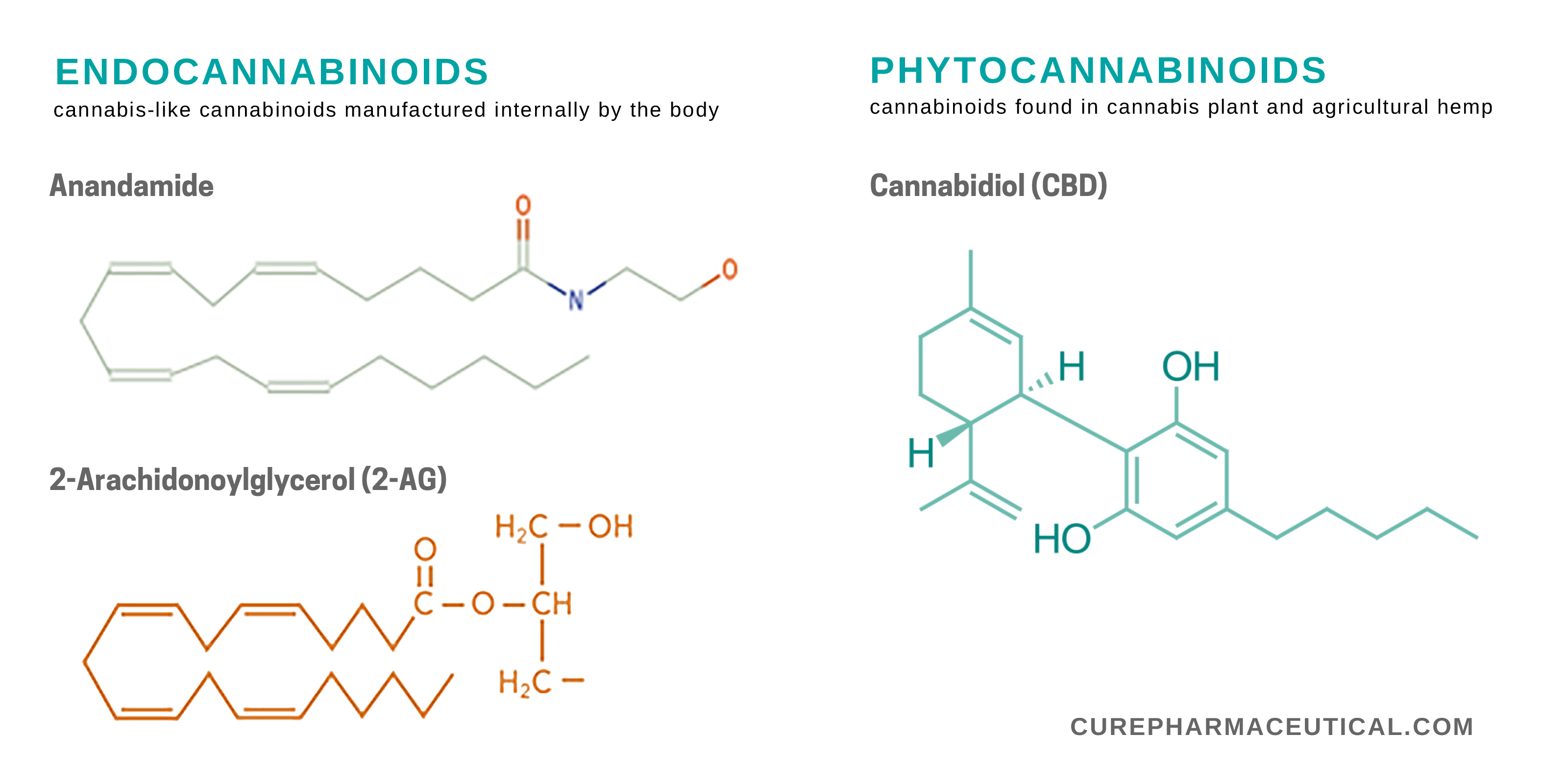
AEA and 2-AG are the most studied molecules of CB1 and CB2 receptors. With the ASD children displaying low levels of these endocannabinoids, there may be a good argument for using CBD to treat ASD in future clinical trials.
Researchers believe that CBD may help raise levels of these endocannabinoids (AEA, OEA and PEA), as CBD may help activate PPARs (nuclear receptor proteins) as well as the receptor channel TRPV1, whilst inhibit the enzyme FAAH, which degrades the endocannabinoid anandamide.
The study’s findings also suggest that CBD could have the potential to correct an impaired endocannabinoid system in those with ASD.
While the results of the study help push the argument for further clinical trials with cannabinoid-based medication, researchers noted the study’s limitations.
ASD is not a unified condition; each child on the autism spectrum is unique in their own beautiful way. Different ASD children may respond differently to cannabinoid-based medications, possibly needing different ratios of cannabinoids (e.g. some may need higher levels of THC than CBD and vice versa).
Children with ASD could have been taking medications which may have impacted the outcome of the research
More studies will be needed to determine whether low levels of endocannabinoids equates to an ASD diagnosis, but the study signals an important step forward in the treatment and early diagnosis of ASD.
The Israeli study may have important implications for epilepsy research.
Between 10-30% of those with autism spectrum disorders also suffer from epilepsy (often drug-resistant forms, such as Dravet Syndrome or Lennox-Gastaut syndrome).
Epilepsy has already been associated with an impaired endocannabinoid system (ECS). As the researchers note in their report, there are already ongoing clinical trials investigating the efficacy of CBD in treating epilepsy.
If CBD can treat both epilepsy and ASD, there is hope that both that there may be safe treatments for these debilitating conditions, opposed to the cocktail of pharmaceutical drugs children with ASD and epilepsy are being prescribed.
Medical cannabis has already been proved to be non-lethal; there has never been a reported overdose on cannabis alone. The side-effects of medical cannabis are relatively mundane; most report a dry mouth or increased tiredness (side-effects most recreational cannabis users are more than familiar with).
Conversely, epileptic and ASD children pumped with pharmaceutical drugs leaving them in a ‘drug haze,’ leaving them with limited cognitive responses, sometimes unable to walk or talk.
British and Irish parents of children with ASD are being forced to take matters into their own hands due to limited access to ‘legal’ medical cannabis in Britain.
Due to CBD being legally available without a prescription in the UK and Ireland, parents are establishing support groups where they share their experiences with different brands and strengths of CBD products for their ASD children.
“CBDs of Autism” is one of those groups, run by parents with children with ASD using CBD, for parents of children with ASD looking to start their own CBD journey.
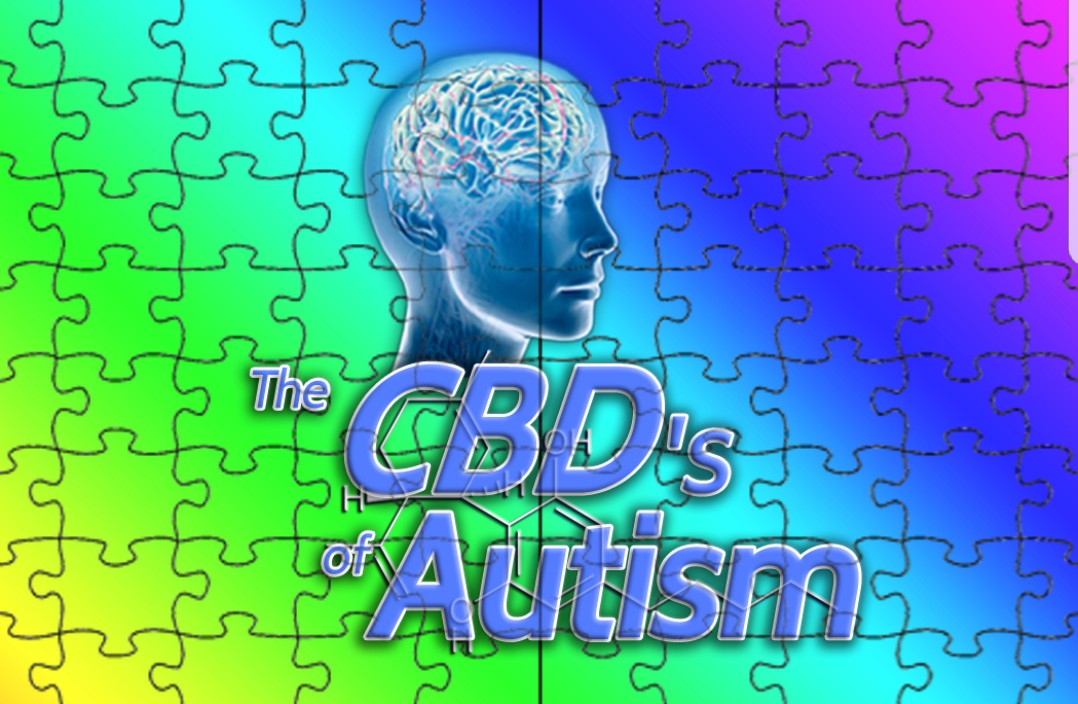
Sharon McEvoy, from Ireland, co-found the group after seeing the amazing success her own autistic child had with CBD.
Sharon explained how her son’s Autism had a debilitating impact on the young child’s development:
“Niall’s Autism umbrella was vast.
“Not only does Niall have autism, but in 2015 was diagnosed with ongoing seizure activity, deemed to be high risk of developing epilepsy. In 2016 He was also diagnosed with an Acquired Brain Injury.
“He was dealing with a lot.
“He was deemed to have severe anxiety, severe speech delay, and ADHD.
He was deemed malnourished as his food intake was limited. He had stunted growth as a result, and a Sensory Processing Disorder.
“He had self-injurious behaviours and would smash his head off the floor continuously.

The high pitch scream. Vocal stimming. Body and vocal tics, he was constantly sick with infection. I could continue on with the list.”
“If I had my time over again, I would have started using CBD oils as early as possible.”
– Sharon McEvoy, Co-Founder of CBDs for Autism and Medical Cannabis Warrior
However, after adding CBD into Neil’s treatment, the young boy’s condition vastly improved, giving him a chance for a normal, healthy life.
“Since starting CBD, we now have no self-injurious behaviour anymore,” Sharon said.
“Doctors couldn’t detect any seizure activity when he was last tested.
“He eats all day, like any other 7-year-old boy. While his diet can be rigid, it is now vast and healthy!
“Vocal stimming and body tics have also stopped, but they do flare again when he is losing his baby teeth, but never to the extent they were at.

“Anxiety is rarely seen now, and when it is, his speech and ability to communicate verbally with us has improved so much, that it is very easily dealt with and quickly dealt with.
“Niall’s quality of life has improved so much, it’s very hard to put into a few sentences.
While CBD has had an amazing impact on Neil’s life, Sharon explained that it is not a ‘cure’ for ASD, but rather a tool to help her child live like any other young child:
“Niall is still Autistic,” Sharon explained, “we are not trying to ‘cure’ or remove his Autism, but I want him to have the happiest childhood possible, just like anyone else.
“My only regret on this whole journey is I took so long researching and trying to make up my mind.
“If I had my time over again. I would have started using CBD oils as early as possible.”
The legal CBD market can be a confusing adventure, even for the most experienced veteran, with 100s of new products and brands cropping up, seemingly every few months.
One of the primary reasons Sharon set up the CBDs of Autism was to help guide other parents through the murky waters of the CBD market.
“We get asked frequently about whether a child will get ‘stoned’ from using CBD, whether CBD is illegal, and whether there is a specific CBD oil for ASD.
“No, your child will not get ‘stoned’ from CBD, but this is a common worry for new members.
“You are looking for the sweet spot, i.e, what is your child’s tolerance to a particular oil. Tolerance varies from strength to strength, from brand to brand.
“So, sometimes if the dose gets too high, parents will know as children can become sleepy and quiet. You just need to bring it down to the previous dose the next day, and all returns to normal.
“You have found the sweet spot for that brand of oil!”
“There is no oil specifically designed for autism, and with research where it currently is, I don’t think there ever truly can be an ASD-specific CBD oil.
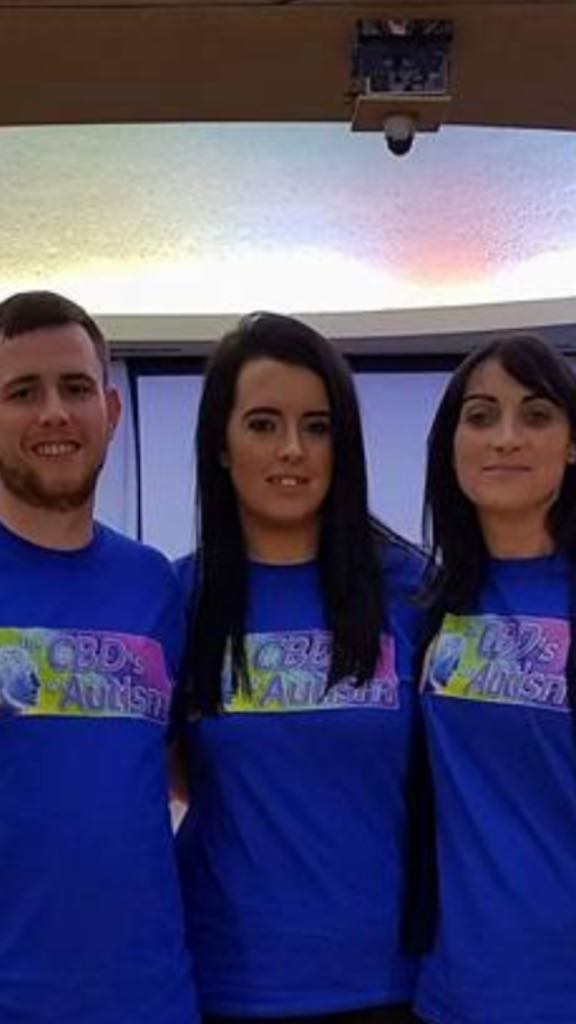
“Autism is unique to each person. It affects everyone differently.
“While a lot of children have co-existing medical conditions, a lot don’t either.
“Oils are so tailored to each individual. It can take trying multiple brands and strengths of CBD to see how each person responds.
“If one family claim a particular oil was beneficial for self-injurious behaviour, it might not have the same effect for another person who self injures.”
Sharon’s experience of Child ASD and CBD products highlights why research like this is needed.
Autism is a complex condition which needs more research to understand potential causes, and, more importantly, how best to treat ASD without subjecting suffers to a lifetime of pharmaceutical medications.
If ASD is indeed related to a cannabinoid deficiency then there is clearly a case for increasing funding for cannabinoid research.
Before cannabis was moved to Schedule II class, it was viewed as a Schedule I drug in the UK, which prohibited research (unless it was to find negative side-effects of the drug).
Now that cannabis has been rescheduled, we should see an influx of research into cannabinoids and their potential medicinal properties.
Like the CBDs of Autism page on Facebook for more information on treating children with ASD with CBD, and like our Facebook page to stay up to date on medical cannabis news.
References and further Reading
Research finds THC more effective than CBD for treating pain
Research finds THC more effective than CBD for treating pain
- Researchers in the USA claim different levels of THC more important in treating chronic pain than CBD
- Over 3,000 patients self-reported their medical cannabis experience were surveyed
- “THC generates measurable improvements in symptom relief.”
A new study has found evidence that THC, the psychoactive compound in cannabis, is more effective than CBD for treating medical conditions such as chronic pain.
Analysing self-reported data collected from over three thousand medical cannabis patients, researchers at the University of New Mexico have provided further evidence to challenge the misconception that THC has limited medical potential.
Researchers collected the data via the ReleafApp, which helps patients track & learn which types of cannabis, dosing, and ingestion methods work best for them, where 3,300 patients logged responses in nearly 20,000 sessions.
The most commonly used product researchers found medical cannabis patients are using for chronic pain was dried flower (the same that politicians call “street cannabis” or “skunk”.)
Dried flower was overall more associated with greater relief for chronic pain than other methods, such as edibles, tinctures and ointments, regardless of the THC content.
Researchers found that cannabis “containing the middle (10–19%) and highest (20–35%) THC potency levels was associated with greater symptom improvement than flower in the lowest THC potency category (0–9%),” whereas variation in CBD levels “was not associated with differences in symptom improvement.”
Variations between Sativa and Indica strains of cannabis had influence over a patient’s overall experience with cannabis.
According to the report, patients using Indica strains had a “greater likelihood of reporting negative side effects and some evidence of fewer positive and more context-specific side effects, relative to hybrid- and Sativa-based products.“
Discussing the results of the study, Jacob Miguel Vigil, PhD, a professor in UNM’s Department of Psychology said:
“Despite the conventional wisdom, both in the popular press and much of the scientific community that only CBD has medical benefits while THC merely makes one high, our results suggest that THC may be more important than CBD in generating therapeutic benefits.
“In our study, CBD appears to have little effect at all, while THC generates measurable improvements in symptom relief.
“Only THC potency levels showed independent associations with symptom relief and experiences of both positive and negative side effects, with higher levels (of THC) resulting in larger effects.
“These findings justify the immediate de-scheduling of all types of cannabis, in addition to hemp, so that cannabis with THC can be more widely accessible for pharmaceutical use by the general public.”
“In our study, CBD appears to have little effect at all, while THC generates measurable improvements in symptom relief.“
– Jacob Miguel Vigil, PhD, a professor in UNM’s Department of Psychology
Due to federal regulations restricting clinical trials on cannabis, researchers find it difficult to produce data. Apps like ReleafApp are providing researchers with the data they are unable to collect themselves.
Three co-authors of the study helped develop the ReleafApp, which has collected information from cannabis users since 2016.
From the study, we can that patients suffering from chronic pain are seeing greater results with strains higher in THC, which according to the British Government is apparently detrimental to our health, opposed to CBD, which is legally available from thousands of retailers in the UK.
More research like the study conducted at the University of New Mexico should be encouraged, which values the opinion of patients as important to building policy on medical cannabis.
Follow us on social media for more medical cannabis news!
References and further Reading
Doctors admit CBD may have caused a lung cancer patient’s tumour to HALF IN THREE MONTHS
Doctors admit CBD may have caused a lung cancer patient’s tumour to HALF IN THREE MONTHS
- Scans from a British cancer patient show CBD halved cancer cells in lung
- 81-year-old from Stoke-on-Trent refused chemotherapy, using CBD instead
- Doctors say that more work is needed into CBD as a treatment for cancer
Scans from an 81-year old lung cancer patient have provided more evidence that cannabinoids have the potential to be used in cancer treatments.
The ex-smoker from Stoke-on-Trent, who has remained anonymous, has amazed doctors by halving the tumour in his lung by only using Cannabidiol (CBD).
The retired salesman, who previously suffered COPD, refused traditional chemotherapy when doctors found a 2.5cm by 2.5cm mass in the man’s left lung in October 2016, with growths in lymph nodes.
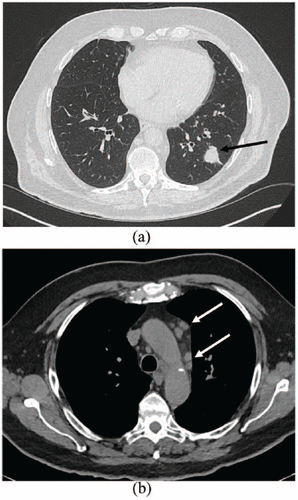
By November 2017, follow up scans revealed the tumour was “near total resolution”, with a “significant reduction in size” of the growths in his lymph nodes.
Now, doctors at the Royal Stoke University Hospital have shared the CT scans which show how his tumours half in size, providing further weight to the argument that cannabinoids should be introduced regular cancer treatments.
According to the doctors who worked the case, the man refused chemotherapy due to his age, in a bid to try and maintain a good quality of life:
“The patient was offered chemotherapy and radiotherapy, but he declined as he was in his 80s and did not want any treatment that could adversely affect his quality of life.”
The man only started his CBD treatment in September 2017. Prior to that, follow up scans show that the tumour was growing.
After a follow up scan in December revealed the tumour had grown to 2.7 by 2.8cm, with another scan in July 2017 showing more growth.
However, after introducing CBD in September 2017, the man’s condition began to greatly improve, amazing medical professionals.
Questioning by the doctors revealed the patient had been taking “MyCBD” 2% (200 mg CBD in 10 ml) from the beginning of September 2017.
For the first week, the patient took 2 drops twice a day, increasing to 9 drops twice a day until the end of September.
A week after a scan in November revealed the tumour had shrunk from 2.7 x 2.8cm to 1.3 x 0.6cm, the patient had to stop using the CBD because he “did not like the taste and caused a slight nausea.”
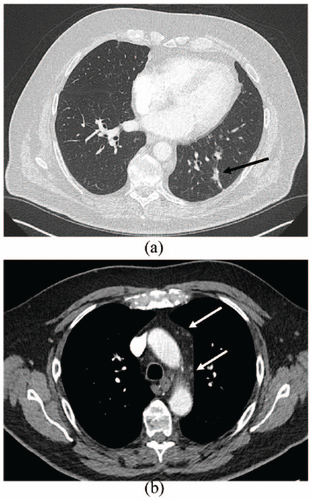
The doctors reported that “he was never physically sick,” and that CBD was the only “change in the patient’s diet, medication or lifestyle from September 2017.”
“CBD could be a potential drug in the treatment of cancer.“
– Royal Stoke University Hospital Report
In their report, researchers discussed how they think CBD could have shrunk the tumours:
“CBD could be a potential drug in the treatment of cancer.
“CBD has been shown to have anti-neoplastic effects in vitro and/or in vivo in lung cancer and other types of cancer.
“It has been described that CBD can act on tumour cells, directly or indirectly, through different pathways and that these effects might vary in different tumour cells.”
The report concludes that CBD “may have had a role” in the amazing reduction of the cancer due to the fact that there is evidence the patient did indeed have lung cancer and there was no other “identifiable lifestyle, drug or dietary changes.“
While this case is a fantastic step forward for medical research into cannabinoids and cancer, the doctors working the case were also careful to withhold from making solid conclusions:
“Further work is needed, both in vitro and in vivo to better evaluate the various mechanisms of action of CBD on malignant cells, and its potential application in the treatment of not only lung cancer but also other malignancies.”
Follow us on Facebook for more medical cannabis news!
House of Lords criticises British Government for failing “desperate” medical cannabis patients
House of Lords criticises British Government for failing “desperate” medical cannabis patients
- Lords slammed the British Government for failing medical cannabis patients
- Only four patients have received a prescription for medical cannabis
- Some patients are forced to travel abroad for their prescriptions
- One Lord claimed “majority of terrorists” in the UK are heavy users of cannabis
Members of the House of Lords slammed the British Government yesterday for failing “desperate” patients needing legal access to medical cannabis.
Cross-bencher Baroness Meacher questioned Conservative Peer, Baroness Blackwood, the Parliamentary Under-Secretary for Health and Social Care, about “what steps are [the Government] taking to ensure that patients in need of medicinal cannabis are able to access such treatment on prescription?”
Despite cannabis being legalised for medicinal purposes in November 2018, only a small handful of patients have been able to acquire a prescription. So far, all of the prescriptions given have been private ones, costing tens of thousands of pounds per year, pricing out the most vulnerable patients in British society.
Jorja Emerson, 2, who suffers drug-resistant epilepsy, has to pay £3,000 every three months for her private prescription, leading her father to demand that medical cannabis be available on the NHS.
According to Baroness Meacher, this lack of access may be attributed to the lack of training and awareness British medical professionals have on the medical properties of cannabinoids:
“Doctors have had no training in prescribing cannabis.
“They need to know the contents, dosages, side-effects and everything else about medical cannabis products.
“The pressure on doctors with desperate patients whose standard medications are not working or are causing unacceptable side-effects is intense. Doctors urgently need government help.”
The decision to prescribe medical cannabis lies solely in the hands of doctors who are on the specialist medical register, restricting access to cannabinoid-based medications for patients.
The Medical Defence Union (MDU) outlines the process a medical professional must go through to qualify as a specialist doctor, able to prescribe medical cannabis. In its outline, the MDU explains the limited circumstances in which cannabis can be prescribed:
“Although the drug will be available to certain patients under specific circumstances, it is still for the specialist doctor to decide whether or not it is appropriate to prescribe a cannabis-based product.
“The doctor remains responsible for the prescribing of the drug and the decisions they make.”
If a medical professional has not been trained in medical cannabis, it is more likely they will be hesitant to prescribe a product they have little knowledge about.
Baroness Meacher addressed this issue, suggesting changes in the NHS which could help make medical cannabis more easily available to those who need it most:
“Will the Minister ensure that the medical director of the NHS makes specialist doctors aware of the new guidelines to be launched later this month by the Medical Cannabis Clinicians’ Society, and of the 12-module online training course already available from the Academy of Medical Cannabis?”
Baroness Blackwood replied:
“This is a challenging area, and the evidence base is still developing.”
Labour Peer, Lord Howarth, challenged Baroness Blackwood’s claim that there is still insufficient evidence for using cannabis as a medication, highlighting another issue that the British cannabis policy has caused: medical cannabis refugees.
Lord Howarth discussed how one patient is being forced to fly to Holland every three months for her prescription of Bedrocan, a medical cannabis product which is currently unavailable in the UK:
“Will the Minister comment on the issues illustrated in the predicament of a person who has been prescribed the cannabinoid dronabinol, branded as Bedrocan, which is the only medication that has proved effective for her following the failure of 35 different medications previously prescribed to relieve her chronic pain from cervical and lumbar spondylosis?
“Given that the Chief Medical Officer stated last summer that there is conclusive evidence that cannabis-based products are effective for certain medical conditions, why is this patient still forced to travel to Holland every three months to obtain the medication that her consultant considers essential for her, and why does confusion still reign over licensing procedures?”
Baroness Blackwood seemed to dismiss Lord Howarth’s , claiming that this should not “As far as I can see, there should be no reason for the situation he has outlined.”
“Doctors have had no training in prescribing cannabis.”
– Baroness Meacher
One of the most bizarre claims made during the questioning was when Labour Peer, Lord West, claimed that cannabis was somehow linked to terrorism, going on to use the derogatory slang-word for cannabis, ‘skunk’:
“The majority of those guilty of violent terrorist crimes in this country are found to be heavy users of cannabis.
“When one looks at violent crime outside of terrorism, it seems again, although I do not know the details, that very often the people involved are heavy users of skunk, not the kind of cannabis that we are talking about but the liquid stuff.
“Are the Government looking at the relationship between the use of these really strong types of cannabis and violent crime, to see whether anything should be done about it?”
It is unclear what evidence the Lord based his claims on, or if he is seriously trying to suggest there is causation between smoking cannabis and wanting to commit unspeakable acts of terror.
There is a possibility Lord West could be referring to when an unnamed ‘friend’ of Salman Abedi, the Manchester bomber, claimed that Abedi “used to drink, smoke weed then all of a sudden he turned religious and I’ve not seen him since 2012.”
So far, however, there has been no research to determine a true link between smoking cannabis and a desire to commit terrorism.
Cannabis is the most commonly used drug in the UK, with 2.4 million adults, (7.2%) of adults aged 16-59 having used it in the last year.
If there were any validity to Lord West’s bizarre claims, there would be more terror attacks in the UK every year.
Baroness Blackwood responded to Lord West’s claim by saying that “the medicines we are speaking about are not skunk.”
The strain of cannabis which GW Pharmaceuticals grows in the UK, however, is literally Skunk #1, meaning that every single patient who has used Sativex has used “skunk.”
Accessibility to medical cannabis in the UK is extremely low. Efforts from members of the British Government, such as Baroness Meacher’s, to fight for more access should be applauded and encouraged.
Patients have a right to medications which have been proven safe and effective by numerous clinical trials and evidence gathered from countries who have legal medical cannabis.
Follow us on Facebook for more medical cannabis news.
Australian researchers launch world’s first clinical trial to treat brain cancer with medical cannabis
Australian researchers launch world’s first clinical trial to treat brain cancer with medical cannabis
- Researchers in Australia became first in world to investigate THC as brain cancer treatment in a clinical trial
- Brain cancers have some of the lowest survival rates
- Glioblastoma (GBM) is the most common type of malignant brain tumour in the UK
- Over 2,000 are diagnosed with GBM each year in England
- Research started back in October 2018
Researchers in Australia launched the world’s first clinical trial last year on medical cannabis and brain cancer last year, investigating the potential cannabinoids have in slowing the growth of glioblastoma, a highly aggressive type of brain tumour.
While research into the efficacy of CBD and THC into treating various cancers already exist, Dr. Janet Schloss and renowned neurosurgeon Professor Charlie Teo became the first to study the effectiveness of THC, in a practical application, as a complementary treatment to chemotherapy, radiotherapy, and surgery for brain cancer patients, particularly those with glioblastoma.
The pair want to determine whether full-spectrum cannabis oil, high in THC, not just CBD, has the potential to help improve current cancer treatments.
Previous research, conducted here in the UK by Dr. Wai Lu at St. George’s University London, has already found evidence that cannabinoids alongside chemotherapy are a more effective treatment for cancer.
The research from Dr Schloss and Prof. Teo, however, is the first time in the world THC has been used in a clinical trial for brain cancer research. They hope to reproduce results from in-vitro research conducted on cannabinoids and cancer, finding more conclusive evidence that THC can help reduce tumours and tumour regrowth.
Reducing tumour regrowth can be vital in increasing survival rates, which are currently extremely low for brain cancer patients.
In the UK, only 14% of patients with brain tumours survive for 10 or more years.
“What we’re really hoping for is to be able to see that the medicinal cannabis aids and assists the standard treatments in reducing tumours, in reducing regrowth, and increasing the person’s end of life quality.”
– Dr. Janet Schloss, lead researcher
The clinical trial is being conducted at the Endeavour College of Natural Health in Australia.
The study itself will involve a randomised trial, where every participant will be provided cannabinoid-based treatments (high in THC) alongside their current cancer treatments, over a 12 week period.
Participants will consume small doses, 2ml of cannabis oil, at night just before bed; the THC content has been limited so that patients won’t have issues waking up or getting to sleep.
BioCeuticals, one of Australia’s leading providers of nutritional and therapeutic supplements, have provided the cannabis oil, specifically manufactured for this glioblastoma study.
Speaking to 4BC, Dr. Scholss explained what they are hoping to achieve from the clinical trial:
“What we’re really hoping for is to be able to see that the medicinal cannabis aids and assists the standard treatments in reducing tumours, in reducing regrowth, and increasing the person’s end of life quality.”
“There’s over 1,000 a year diagnosed with GBM in Australia alone. The survival rate is usually less than a year.. some people can be gone within 6 months.
So, something that we can find which helps reduce the tumour growth, as well as decreasing the risk of regrowth, will make a big difference to so many people’s lives.”
Research on the potential medicinal applications of cannabinoids has increased in Australia following a rescheduling of cannabis in 2017, similar to the recent reclassification in the UK.
Previously, research into cannabis, in both the UK and Australia, could only be conducted if it was investigating the side-effects of the plant when used as a recreational drug.
With more research, we are gaining more and more evidence that cannabis has great potential to be used alongside current treatments, such as chemotherapy and radiotherapy.
There is already a bounty of anecdotal and preliminary evidence that cannabinoids can help treat cancers, in particular helping to improve the quality of life in terminal cancer patients.
Hopefully, the research conducted by Schloss and Teo will help improve the survival rates of brain cancer patients.
Over half of seniors who have tried CBD report an “Improved Quality Of Life”
Over half of seniors who have tried CBD report an “Improved Quality Of Life”
- Study of 1,000 seniors found 9% tried CBD for medical purposes
- 51% of those reported an improved quality of life
- 61% reported a reduction in pain
- Inflammation was the primary reasons seniors are using CBD (42%)
- 89% said they would recommend CBD to family or friends
A new study has found fresh evidence that cannabidiol (CBD) truly is helping improve the quality of life of our elderly.
The study, released by Remedy Reviews, found that of the 1,000 seniors (aged 54 or older) surveyed, 9% have tried CBD for medicinal purposes.
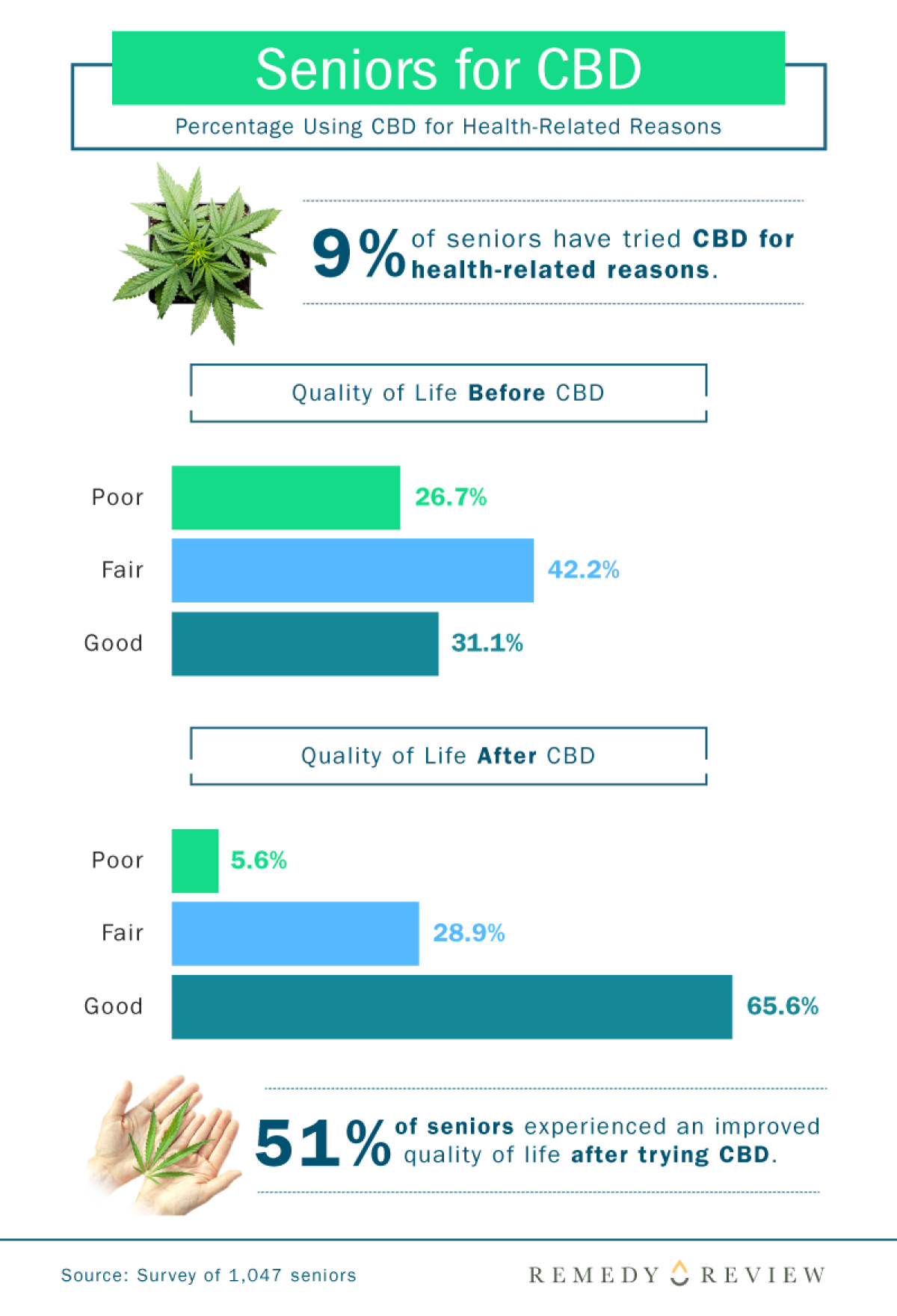
An amazing 51% of those who have tried CBD reported an improvement in quality of life, with 65% reporting a ‘good quality of life,’ while only 31.1% reported the same quality of life prior to trying CBD.
Due to CBD’s anti-inflammatory properties, it’s not surprising that inflammation was the most common condition seniors are using CBD for; 42% said they were using CBD to deal with inflammation, with chronic pain coming in for a close second (41%).
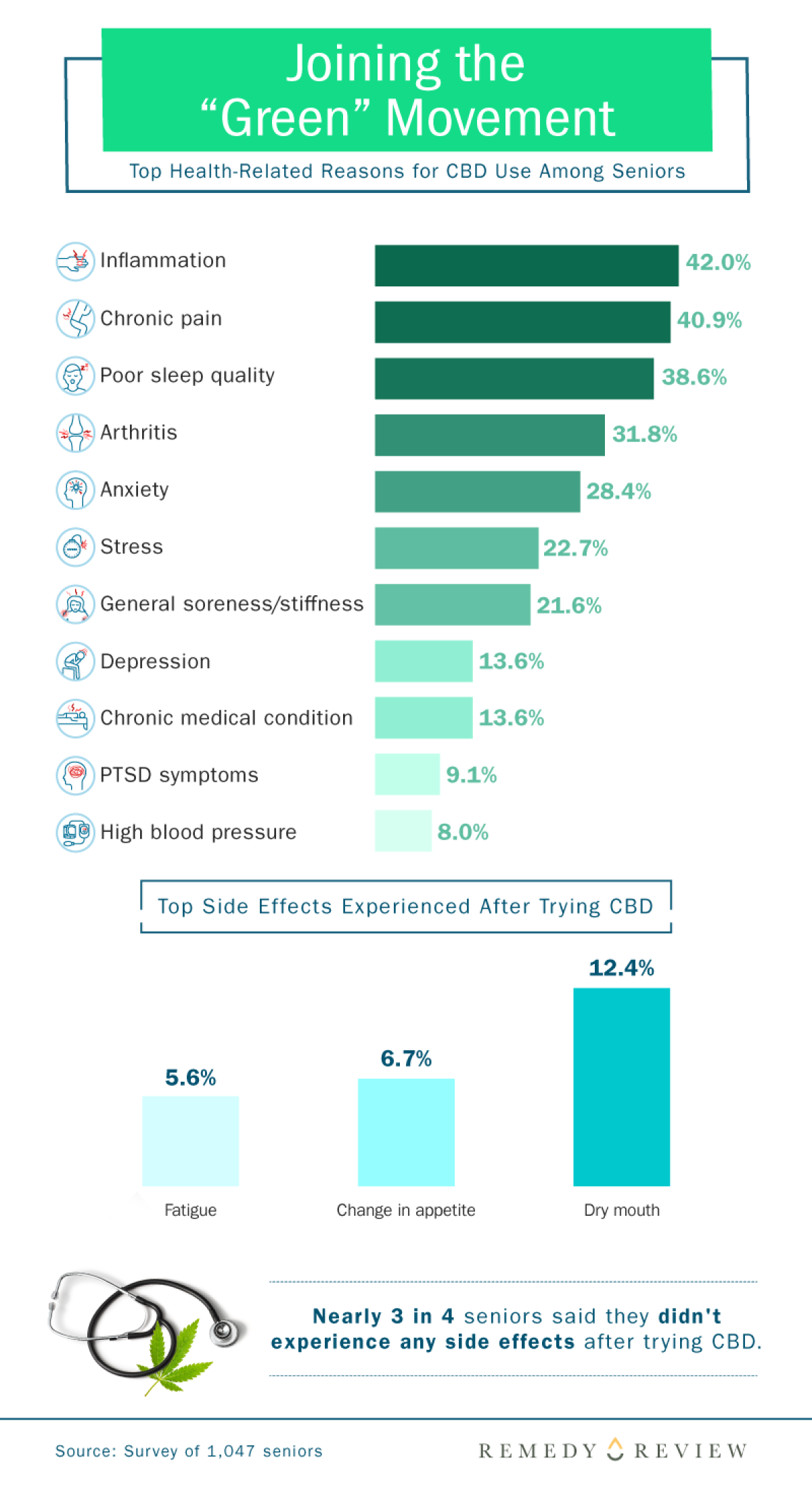
This could be significant for the future of healthcare in the UK, as 43% of people in the UK experience chronic pain. More adults aged 75 or over (62%) experienced pain than those aged 18 to 25 (14.3%).
The study found that 61.1% of seniors that tried CBD found success in reducing pain.
If nearly half of our adult population suffers from chronic pain, CBD could revolutionise the way we help chronic pain suffers deal with the potentially debilitating illness.
Due to the growing opioid crisis in America and the UK, CBD could offer a safer alternative to dangerous and addictive pharmaceutical drugs.
Nearly 29% of respondents rated CBD as “extremely effective”, while another 38.9% said it was ‘moderately effective’.
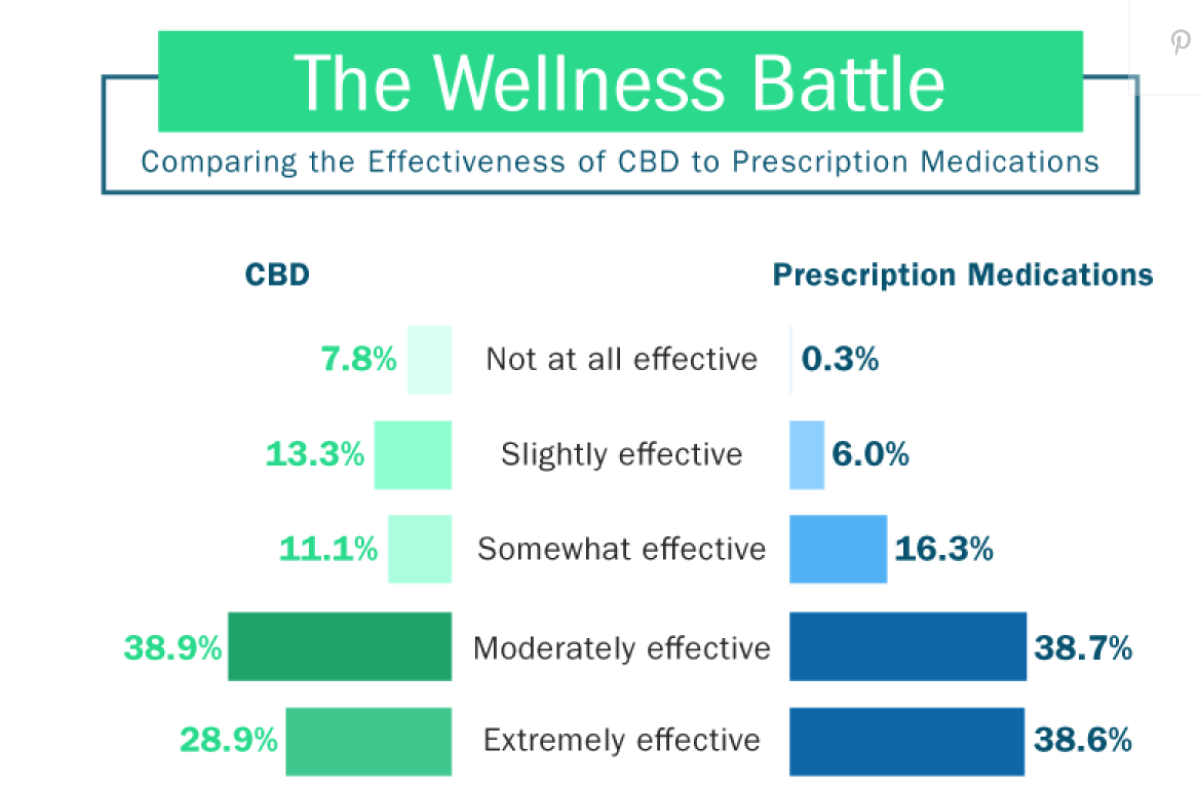
While more seniors rated prescription medication as being ‘extremely effective’ (38.7%), CBD does not carry the same potential to negatively impact one’s health.
Research from Israel found that medical cannabis is “significantly safer” for elderly patients than opioid medication.
“Over 65 percent of the seniors who tried CBD said their quality of life was good, whereas just 31.1 percent said the same before trying CBD.”
– Remedy Reviews
If CBD is working as well as pharmaceuticals but carries less risk through side-effects (cannabinoids are non-lethal, it is impossible to die from an overdose of cannabis), there is a good argument to be put forward that we should be introducing CBD products into treatment programmes.
In fact, nearly 3/4 of seniors reported no side-effects, with the only side-effects reported by those surveyed being dry mouth (12.4%), a change in appetite (6.7%), and fatigue (5.6%).
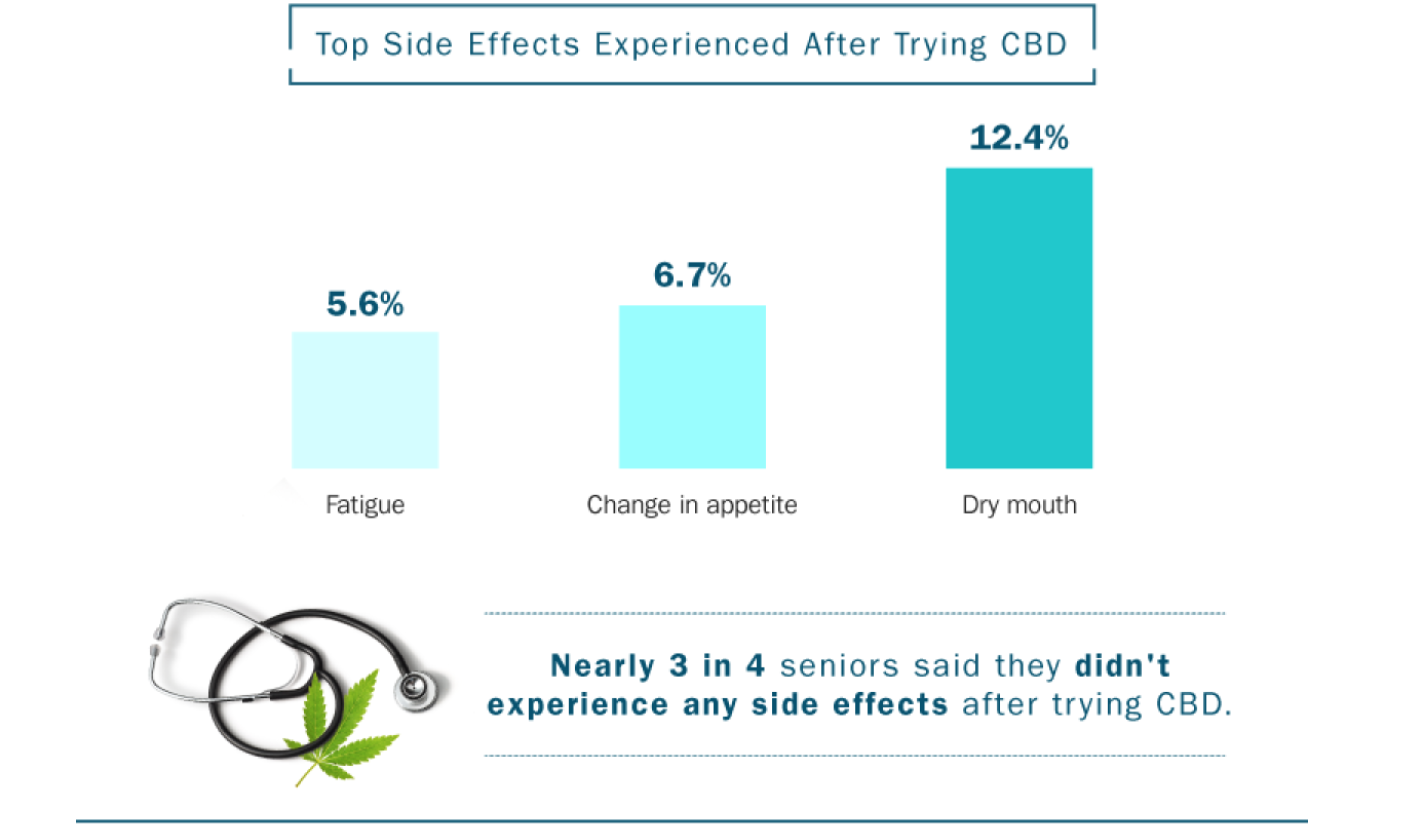
The most popular method of ingesting CBD was via oral drops (tinctures), with 54% of seniors opting for this method, with the least popular being via vaporisers or smoking (10%).
While the results from the survey are encouraging, more research is needed before any solid conclusions can be made.
Researchers admitted that the main limitation of this study is that the reported benefits and side effects are based on self-reporting. So far, the findings have not been reviewed or approved by medical experts.
However, research like Remedy Review’s survey helps to build a framework to build upon.
Document shows cannabis corporations may have influenced New York Governor against Grow Your Own
Document shows cannabis corporations may have influenced New York Governor against Grow Your Own
- Cannabis corporations are trying to influence recreational cannabis policies
- NYMCIA want home cultivation of cannabis banned in New York State
- Activists reject NYMCIA’s claims that they are anti-home cultivation on grounds of public safety and “fears” NY could lose out on taxes
Grow Your Own (GYO) is one of the most significant goals cannabis activists hope to achieve in their push for wider access to medical cannabis.
The policy allows patients to cultivate strains tailored for their specific medical condition, as well as reducing the overall costs of medical cannabis. GYO also enables patients with restricted mobility to access medical cannabis from their own home.
For cannabis customers in States with recreational access, GYO affords them the ability to massively reduce the cost of purchasing from often pricey dispensaries.
Large cannabis companies, however, clearly see GYO as a direct threat to their profits.
New evidence, revealed by Marijuana Moment, shows cannabis companies have tried to prevent GYO policies in New York State.
New York Governor, Andrew Cuomo (D) has previously expressed a reluctance to introduce medical cannabis policies, last year claiming cannabis should remain illegal as it is a “gateway drug.
Cuomo is now advocating for legalisation, a move which took many activists in America by surprise.
The Governor’s sudden change in heart might be explained in the details of his proposed legalisation plan. The proposal would ultimately ban home cultivation on recreational cannabis.
Currently, the only State with recreational access to employ a ban on GYO is Washington State.
A month prior to Cuomo announcing the details of his plan to legalise recreational cannabis, New York Medical Cannabis Industry Association (NYMCIA), led by executives of the major licensed medical cannabis providers, sent Cuomo’s office a statement, offering “some thoughts on various issues associated with a transition from medical to adult-use.”
One of those thoughts centred on a desire to prevent consumers from growing their own cannabis.
A chapter in Cuomo’s cannabis proposal, titled “The Fallacy of Home Grow,” puts forward very specific arguments against allowing GYO.
While NYMCIA acknowledges that people desire GYO due to “currently high prices of medical marijuana,” or due to GYO being viewed as an “individual civil liberty,” they believe GYO “creates a significant public safety and black market risk.”
NYMCIA listed five main reasons why they oppose GYO:
1. Home grow will make it impossible for the state to eliminate the black market.
2. Home grow will make it impossible for law enforcement to distinguish between legal and illegal products, thus frustrating enforcement efforts.
3. Home grow will undermine the state’s harm reduction goal of ensuring that cannabis sold in New York State is grown without noxious pesticides or other contaminants.
4. Home grow will undermine the state’s public health interest in ensuring that cannabis sold in New York State is tested, packaged, and and labeled correctly.
5. Home grow will cost the state tax revenue, thus hindering the state’s ability to fund priorities such as drug abuse treatment and community investment.
While there can be some valid concerns from NY State that it could potentially miss out on some tax by allowing GYO, it seems more likely that the greater concern for NYMCIA would be a loss in their profits.
Reacting to the NYMCIA’s reasons for opposing GYO, Erik Altieri, executive director of cannabis advocacy group NORML, said:
“From our perspective, it’s really hard to see any real reason—other than individual and corporate greed—to be against home cultivation at this point.
“There’s not a lot of rational concerns when it comes to allowing a limited amount of plants for an individual to grow at home.
“To advocate against home cultivation given all we know about how it works in practice from the industry side really just is kind of despicable and illustrates their greed, that they’re willing to sacrifice individual freedoms for the slightest increase in their profits.”
“We need to make sure that we have a check on the potential greed of the industry that we can already see in these early stages based on this advocacy document.
“We need to make sure that the market in New York not only begins to address all the harms caused by the war on cannabis but also is oriented toward the consumer and not large industry interests.
“Banning home cultivation benefits no one but corporations and large industry groups.”
Melissa Moore, New York deputy state director of the Drug Policy Alliance, also expressed concerns about NYMCIA’s claims, raising the very valid point that other states, who have allowed GYO, have not seen any of the dangers NYCMIA are apparently concerned about:
“It’s really disingenuous to try to say that it would not be possible to eliminate the illicit market if we allow for home grow.
“That certainly hasn’t been the experience of other states that allow home grow.”
Other major American cannabis industry groups, such as the National Cannabis Industry Association (NCIA), have also argued against NYMCIA’s ‘fears’ about GYO.
Explaining why NICA oppose a ban on GYO, Morgan Fox, media relations director at the group, said to Marijuana Moment:
“NCIA does not oppose limited home cultivation.
“In fact, it can act as an incubator for people to develop skills which can be used in the legal cannabis industry, which benefits businesses as well as individuals looking to enter the market.
“Much like home brewing has helped spur interest the craft beer market, limited home cannabis cultivation can do the same in legal states.”
“We need to make sure that we have a check on the potential greed of the industry that we can already see in these early stages based on this advocacy document.“
– Erik Altieri, executive director of NORML
NYMCIA list several large cannabis companies as members, including Columbia Care, Etain, PharmaCann, The Botanist and Acreage NY, Vireo Health and MedMen.
Speaking to Marijuana Moment, Jeremy Unruh, director of public and regulatory affairs at PharmaCann, explained that the document was NYMCIA’s “first go at formulating some broad policy positions,” prior to meeting with the governor’s office.
“Those policy points you have are sound, but our positions have evolved (and will continue to do so) as we’ve had a chance to socialize these concepts with other stakeholders.”
While Unruh and the rest of the NYMCIA board oppose GYO for recreational use, they do “support the Governor’s homegrown proposal,” which might allow for a GYO option for medical cannabis patients.
But ultimately, “Our position is this: We support the governor’s homegrow proposal,” he wrote in an email.
While recommending that lawmakers ban personal cultivation of recreational marijuana, Cuomo did include a home grow option for medical cannabis patients in his budget plan.
While New York State’s Governor, Cuomo, seems to be in the pocket of large corporations, NY’s Mayor, Bill de Blasio, has expressed his desire to curtail their influence over local cannabis policies:
“Legalization can follow two routes.
“In one, corporate cannabis rushes in and seizes a big, new market, driven by a single motive: greed.
“In another, New Yorkers build their own local cannabis industry, led by small businesses and organized to benefit our whole diverse community.”
It seems the only people NYMCIA are targeting are recreational customers (or medical cannabis patients without a prescription for a specific, recognised medical condition).
It is fairly obvious that the businesses which make up NYMCIA could potentially lose some of their profits if some of their customers are able to grow their own cannabis; recreational cannabis businesses are after all, essentially a middle-man enterprise.
But just like home brewing didn’t spell the end for the alcohol industry, GYO shouldn’t eliminate cannabis corporations from the cannabis industry.
Some people are not able to grow cannabis at home, either due to lack of skills, space or time.
There will still be a market for recreational users who want to purchase high-quality cannabis products. GYO merely offers more options to cannabis customers, which should never be scorned in a capitalist society.
It is quite obvious that NYMCIA’s affiliates have a financial stake in the shape of whatever marijuana law eventually emerges from the New York legislature.
Are members of NYMCIA genuinely concerned that GYO would maintain the black market, complicating the legalisation process? Or truly worried about the potential public health impact GYO could have? Or, is it more likely that businesses want a monopoly on the cannabis market?
New research claims 7% of Americans already use CBD
New research claims 7% of Americans already use CBD
- Nearly 7% of Americans are already using CBD, survey finds
- Researchers at Cowen estimate the CBD market could reach $16 billion by 2025
- CBD most popular among 18-34-year-olds
- Tinctures account for 44% of use, followed by topicals at 26%
New analysis has found that nearly 7% of Americans are already using increasingly popular cannabidiol (CBD) products.
Researchers at Cowen & Co. now estimate the CBD market could grow to $16 billion by 2025
Cowen survey 2,500 adults in a January consumer survey, finding 6.9% of respondents already use CBD as a supplement.
Cowen analyst Vivien Azer expressed her surprise at the survey’s results in a note:
“This initial response piqued our interest considerably, as it was much higher than we would have suspected.”
Cowen now “conservatively” estimates CBD use growing to 10% of U.S. adults (25 million consumers) by 2025.
This implies a potential of the CBD market reaching up to $16 billion in market opportunity.
The Cowen survey found that CBD use is highest among consumers aged 18 to 34.
The most popular form of consumption are tinctures, which account for 44% os users, followed by balms and topicals at 26%, capsules at 22% and beverages at 19%.
“This initial response piqued our interest considerably, as it was much higher than we would have suspected.”
– Vivien Azer, Cowen analyst
The U.S. farm bill, passed in December, makes hemp-derived CBD legal under certain circumstances.
The U.S. Farm Bill, which was passed in December, removed hemp-derived products (A.K.A CBD) from Schedule I status, legalising the cannabinoid on a federal level.
However, the Food and Drug Administration prohibits CBD from being marketed as a dietary supplement, as well as preventing retailers from mentioning CBD’s potential therapeutic benefits.
All CBD products sold in America must be approved by the FDA before it’s available to sell to customers.
Cowen’s groundbreaking research has given us an insight into the potential of the CBD market. With 7% of Americans already regularly using CBD products, it’s clear that the non-psychoactive cannabinoid is here to stay.
CBD has seen a similar explosion in popularity in the UK.
Recent reports indicate that in the UK, the number of people using CBD oil is estimated to have reached around 300,000 already, with some CBD organisations estimating that number could double in a year.
Despite the recent announcement that British trading watchdogs are planning to ban sales of CBD oil for up to 18 months, the non-psychoactive cannabis supplement is clearly making a big impact in the way British people view cannabis, especially as a potential medicine.
Have you tried CBD and had success? We would love to hear about your CBD success stories!



